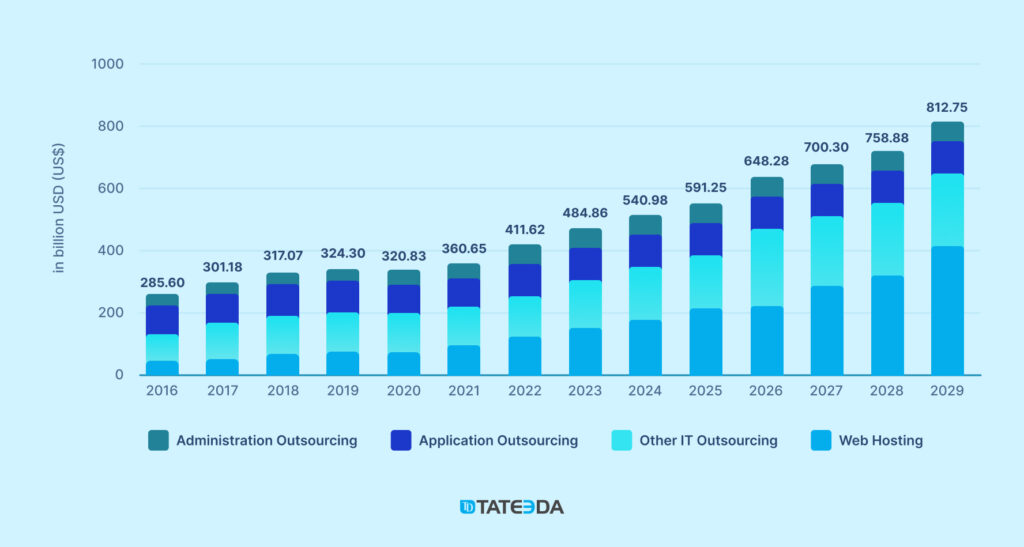Time and Material vs Fixed Price: What Should You Choose?

This guide helps you compare time and material vs. fixed price to define the best fit for project-based work, especially in the context of developing software or other IT projects. The article delves into the substantial difference between fixed price and time and material contracts.
It offers insights into the advantages and disadvantages of each model, which is efficient for collaboration with IT service vendors or staff augmentation partners.
By 2024, the IT outsourcing market is set to hit a whopping US$541 billion, with a projected 8.48% annual growth rate (CAGR 2024-2029), reaching US$812.70 billion by 2029. The United States will lead the charge, generating an impressive US$197.30 billion in 2024 alone.

Businesses aim for profitability, which depends on various factors, including the types of contracts with customers. The time and materials vs. fixed fee contract models are common choices in the domain of IT project outsourcing services.
When starting outsourced software development, selecting the appropriate pricing contract is your initial challenge as a client. This choice between the two models is equally valid when dealing with IT outsourcing firms in offshore and nearshore software development jurisdictions.
When comparing fixed price vs. time and materials contract models, service providers often choose fixed price contracts when the project scope and costs are well understood. For example, a contractor experienced in remodeling kitchens knows that materials and labor typically cost around $15,000, so they might propose a fixed price of $17,500, including a margin for profit.
In comparing the time and materials vs. fixed fee models, the time and materials contract is more suitable for larger projects with less upfront clarity about the full scope of work. For instance, consider a software developer tasked with creating a new e-commerce platform.
In a time and materials contract, the developer and client agree on prices for specific project elements (like labor and tools), but the final cost, which includes the provider’s profit, isn’t determined until the project is completed. To manage costs, the client might include a “not-to-exceed” clause, setting a maximum spending limit.
Table of Contents
Understanding the Pricing Models: Fixed Price Contract vs. Time and Material
Deciding between the time and material vs fixed price models is more than a financial decision; it’s about strategically aligning your approach to the complexities of software development. Whether it’s managing the costs of a dedicated development team, estimating expenses for custom EHR/EMR software development, or navigating the nuances of offshore software development services, each model offers distinct benefits. This introduction lays the groundwork for exploring how these models fit into the broader context of custom software development and engineering costs, helping you make informed choices that impact project success and efficiency.

Learn more: ➡️ The Top 8 Web Development Companies in San Diego
Time and Materials (T&M) Scenario:
Under a time and materials contract, clients are billed based on the actual time spent by developers and other IT specialists on the project. This model allows for flexibility, as clients can modify the scope and requirements as needed throughout the development process.
- When to Use: T&M contracts are preferable for long-term projects or projects with evolving requirements where flexibility is essential.
- Why Use: They offer the flexibility to adjust project scope and requirements as needed, making them suitable for projects with changing business needs or uncertain requirements. They also eliminate the risk of overestimation or underestimation of project costs, as clients pay for the actual hours worked.
| Advantages | Disadvantages |
| Flexibility: Scope can be adjusted throughout the project. | Unfixed Budget: The final cost cannot be determined upfront. |
| Relevant Solutions: Adapts to changing business needs. | Uncertain Deadlines: Timeline can change based on scope. |
| No Risk of Wrong Estimation: Pay for actual development. | Proactive Client Involvement: Requires continuous engagement. |
| Quick Start: Development can begin without detailed specs. |
Fixed Price Scenario:
In a fixed-price contract, the service provider and client agree on predetermined costs, project scope, and deadlines. Once signed, these parameters cannot be changed without renegotiation. This model requires detailed planning upfront to provide accurate estimates and scope.
- When to Use: Fixed price contracts are suitable for short-term projects or Minimum Viable Products (MVPs) where the project requirements are well-defined and unlikely to change significantly.
- Why Use: They provide budget certainty and predictability, making them ideal when clients have a clear vision of the final product and want to avoid unexpected costs.
| Advantages | Disadvantages |
| Fixed Costs: Budget certainty for clients. | Lack of Flexibility: Changes require renegotiation. |
| Predictability: Clear timeline and budget. | Long Planning Process: Detailed upfront planning is required. |
| Easy Monitoring: Progress tracking is simplified. | Risk of Overpayment: Potential for paying more than needed. |

Learn more: ➡️ Top 7 Mobile App Development Companies in San Diego
Detailed Comparison: Time and Material vs Fixed Price
In this section, we detailly compare two prevalent contracting models in project management: Time and Material vs Fixed Price, and vice versa. These approaches have distinct characteristics and implications across various project dimensions such as cost control, scope management, project oversight, and risk management, including in areas like custom mobile development and custom web solution development.
Choosing the right contract type is essential to align with the project’s objectives, budget, and need for flexibility. This comparison aims to highlight the unique advantages and challenges each model presents, aiding in informed decision-making for project execution, particularly when it comes to developing custom offshore mobile services and web solutions offshore.
Cost Control and Budgeting: ??
In a fixed-price contract, the budget is determined upfront, providing a clear financial framework for the project. However, any changes to the scope can lead to additional costs, which may require renegotiation.
On the other hand, a time and materials contract allows for more flexibility in budgeting. While the initial estimates are based on resource efforts, the client can adjust the budget as the project progresses and requirements evolve.
Scope and Flexibility: ??
With a fixed-price contract, the scope is clearly defined at the beginning of the project. This can provide a sense of security and predictability. However, any changes to the scope may require a contract renegotiation, which can be time-consuming and costly.
In contrast, a time and materials contract offers more flexibility in scope changes. This allows the project to adapt to evolving requirements, providing greater agility and responsiveness to client needs.
Project Management and Oversight: ??
In a fixed-price contract, the service provider has more responsibility for project management, as the scope and timeline are predefined. This can reduce client involvement, allowing them to focus on other aspects of their business.
However, this can also lead to less transparency and control over the project. In a time and materials contract, the client has more involvement in project management. This can lead to a more collaborative approach, with the client providing input and feedback throughout the project, ensuring that their needs are met.
Risk Management: ⚠️?️
Fixed price contracts can provide a sense of security, as the budget and timeline are fixed. However, this can also lead to greater risk, as any changes to the scope can lead to additional costs and delays.
Time and materials contracts offer greater flexibility and adaptability, reducing the risk of unmet expectations. By allowing for changes to the scope and timeline as needed, this model can help mitigate risks and ensure the successful delivery of the project.
| Aspect | Fixed Price | Time and Materials |
| Cost Control and Budgeting | Provides a stable financial framework with a budget set in advance. | Offers dynamic budget flexibility, adjusting as project demands and resource allocations evolve. |
| Scope and Flexibility | Sets the project scope at the outset, ensuring predictability but may require renegotiation for changes. | Provides adaptability in scope, allowing adjustments to meet evolving project requirements with greater agility and responsiveness. |
| Project Management and Oversight | Demands minimal client involvement, with the service provider managing defined scope and timelines. | Encourages active client participation, fostering a collaborative environment and ensuring alignment with client expectations. |
| Risk Management | Delivers budget and timeline certainty, although scope modifications can increase risks. | Enhances project adaptability and minimizes the risk of unmet expectations by permitting scope and timeline adjustments as necessary. |
Exploring the Pros and Cons of Fixed Price Contracts
The debate between fixed bid vs time and material is pivotal when discussing project management strategies. Fixed price contracts offer a predefined framework for a project’s scope and cost, appealing to those who value stability and predictability. This model is often favored in scenarios where clear requirements and a defined schedule are established from the start.
Advantages of Fixed Fee Contracts:
- Crystal Clear Clarity: Fixed price contracts lay out project deliverables and total costs transparently, minimizing misunderstandings and ensuring alignment right from the start.
- Precision in Scope: These contracts specify the scope of work, phases, and deadlines clearly, setting precise expectations and facilitating effective planning and management.
- Guaranteed Profit Margins: Service providers benefit from a predetermined profit margin, calculated from a set project cost, which ensures financial predictability.
- Simplified Management: With fixed costs, these contracts are easier to administer due to reduced need for meticulous expense tracking, streamlining project management.
Disadvantages of Fixed Price Contracts:
- Risk of Cost Overruns: Unexpected challenges can incur additional costs not accounted for in the initial budget, potentially reducing profit margins for providers.
- Rigidity in Scope Adjustment: Any requirement changes from the client can complicate the contract, necessitating amendments or change orders, which might delay the project and add administrative burdens.
Pros and Cons of Time and Materials Contracts:
In the ongoing debate of “fixed price model vs time and material,” time and materials contracts stand out for their adaptability and responsiveness to changing project dynamics. This model is particularly suited for projects where requirements are expected to evolve, offering a flexible approach that can accommodate such changes.
Advantages of the Time & Materials Contracts:
- Enhanced Flexibility: These contracts are designed to accommodate changes during the project, allowing for scope and requirement adjustments to better meet evolving client needs.
- Iterative Adaptability: Time and materials contracts support a dynamic project approach, making it possible to refine or alter the scope as the project unfolds.
- Transparent Costing: This model promotes cost transparency for labor and materials, fostering trust and clearer financial relationships between clients and providers.
- Increased Profit Opportunities: Providers might see higher profits as project scopes expand, incentivizing top-notch performance and efficiency.
Disadvantages of the Time & Materials Model:
- Complex Management Needs: Compared to fixed price contracts, time and materials contracts can be more complex to establish and maintain, requiring detailed and sometimes cumbersome expense tracking.
- Intensive Expense Documentation: The necessity for meticulous tracking of all expenses demands robust documentation and management, which can be particularly challenging without automated systems.
- Potential for Budget Exceedance: Without a cap on expenses, clients risk facing budget overruns, especially if the project scope widens extensively, leading to financial unpredictability.
Each contract type offers unique benefits and challenges, making the choice highly dependent on the specific nature and requirements of the project at hand.
How to Choose the Ideal Project Management Model: Fixed Cost vs Time and Materials
Deciding on the perfect project management model is a nuanced journey that hinges on aligning with the project’s specific requirements.
Here’s a personalized guide to making that all-important decision:
Understanding Project Size and Complexity:
The dimensions and intricacies of your project play a critical role in guiding your choice. Large and complex projects may need the breathing room provided by a flexible model to accommodate their layered elements, while smaller, straightforward tasks could thrive under the predictability of a fixed approach. It’s about matching the model with the project’s unique challenges.
Assessing Clarity of Requirements:
Do you have a crystal-clear roadmap for what your project needs? If you can tick all the boxes on your project’s requirements upfront, a fixed price model could be your best bet, ensuring everything is agreed upon and predictable. However, if your project is more like a journey of discovery, where you expect to refine goals as you go, opting for a time and materials model could give you the adaptability you need.
Evaluating Your Risk Comfort Zone:
Consider your comfort level with uncertainty. Projects come with their share of risks, and your model choice should reflect how much variability you can handle. If the thought of unexpected costs keeps you up at night, a fixed price model can put your mind at ease by capping expenses. But if you’re willing to navigate through some uncertainties for the potential of greater adaptability and possible benefits, then a time and materials model might be more your speed.
| Step-by-Step Plan to Select the Right Project Management Model |
| Step 1: Define the Project Scope Clearly outline what the project entails, including all expected deliverables and deadlines. Understanding the full scope will help you assess the complexity and size of the project. |
| Step 2: Assess Requirement Clarity Evaluate how well you understand the project’s requirements. Are they detailed and unlikely to change, or could they evolve as the project progresses? |
| Step 3: Determine Risk Tolerance Consider your or your client’s comfort level with financial and project risks. Reflect on how well you can handle unexpected changes in scope or budget. |
| Step 4: Compare Contract Models Review the characteristics of both fixed price and time and materials contracts. Consider which model aligns better with the project’s scope, requirement clarity, and acceptable risk level. |
| Step 5: Make a Decision Based on your evaluations, choose the model that best fits the project’s needs and your risk management preferences. This choice should also align with your goals for cost predictability and flexibility. |
| Step 6: Prepare for Negotiation Once you have selected a model, prepare to negotiate the terms with all parties involved. Ensure that the contract reflects the agreed-upon model and conditions. |
Real-World Scenarios: Choosing the Right Pricing Model
Scenario 1: Tech Startup Developing AI Platform – Time and Materials Model
A tech startup is creating an AI-driven tech platform, expecting regular updates based on user feedback. They choose a time and materials contract for its flexibility, allowing them to adjust features as insights are gained. This model supports a dynamic development process, with payments based on actual hours worked, ensuring resources are used efficiently without over or underestimating costs.
Scenario 2: Restaurant Chain Launching Reservation App – Fixed Price Model
A large restaurant chain has decided to develop a simple reservation and ordering app with well-defined features. They opt for a fixed-price contract, which offers cost certainty and ensures the project stays within budget. This model is perfect for projects with clear, unchanging requirements, providing a straightforward path to a timely launch, essential for the busy holiday season.
Summary:
These examples illustrate how choosing the right pricing model—time and materials for evolving projects and fixed price for straightforward tasks—can significantly influence project success.
Achieve Project Success with TATEEDA
To conclude, the choice between time and materials and fixed price contracts is crucial for project success:
- Time and Materials: Offers flexibility for evolving projects.
- Fixed Price: Provides predictability and budget control for well-defined projects.
At TATEEDA, we deliver custom software projects across the health-tech, IoT, fintech, and biotech sectors. We understand the importance of selecting the right pricing model, and we’re here to help:
- Tailored Guidance: We assess your project needs to recommend the best model.
- Expert Solutions: Our expertise ensures your project aligns with your business goals.
Contact TATEEDA today to ensure your project’s success with the optimal contractual approach.
Time and Materials or Fixed Price Contracts?
We help you create a dedicated team or extend your tech capabilities with added resources, including developers and testers.








